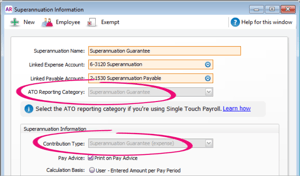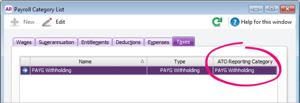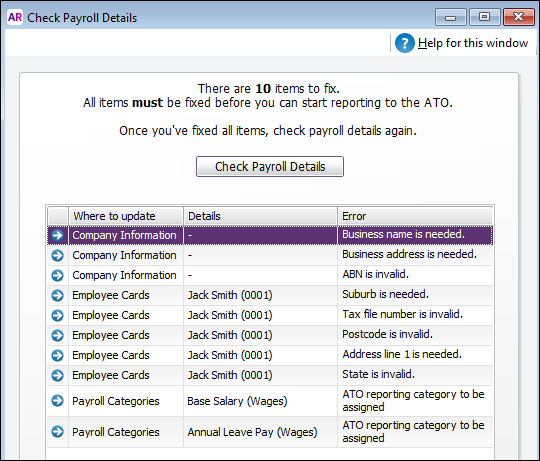So that the ATO knows how to treat each type of payment you're reporting through Single Touch Payroll, you need to assign an ATO reporting category to each of the payroll categories you use.
As your business, award and employee agreement are unique, we can't specify what ATO reporting category you should assign to your payroll categories in this blog post. For additional information and advice, consult your accountant or bookkeeper. Don't have a bookkeeper? Contact us to get some professional advice!
These categories are similar to the ones used when doing payment summaries in previous years.
These fall into 4 Main Types
- Wages
- Superannuation
- Deductions
- Taxes
Wages
| New ATO Reporting Category | More Info | ATO Link |
| Gross Payments |
Include all your payroll categories you use for paying salary and wages. This includes categories for;
There are more categories and some exceptions to these. Do not include salary sacrifice payroll categories. Gross payments are reduced automatically when you assign pre-tax deductions and pre-tax superannuation categories such as salary sacrifice. |
Gross Payments |
| Allowance - Car Allowance - Transport Allowance - Travel Allowance - Meals Allowance - Laundry Allowance - Other |
This includes payments you made to cover your employees’ work-related expenses, like tools or phone. For allowances that don’t sit into any of the main categories, assign them to Allowances – Other. Typically, you wouldn't include amounts you paid for living-away-from-home allowance because these amounts are not assessable income (but check this with the ATO). |
|
| Lump Sum A - Termination Lump Sum A - Redundancy Lump Sum B Lump Sum D Lump Sum E |
Lump sum payments may include payroll categories such as:
Lump sum payments are a complex area. Chat to your advisor or check with the ATO for more guidance. |
Taxation of termination payments |
| CDEP Payments |
Assign payroll categories for:
|
CDEP payments |
| Exempt Foreign Income | This could be assigned to payroll categories such as salary, wages, commissions, bonuses and allowances that are exempt from Australian tax. | Exempt foreign employment income |
| ETP - Taxable component ETP - Tax free component |
These are payroll categories used to track the taxable and tax-free components of employment termination payments. ETPs are concessionally taxed up to a certain limit, or 'cap'. Certain types of termination payments are tax free up to a certain limit, for example, if the ETP is because of redundancy or early retirement. |
Taxation of termination payments |
Superannuation
The ATO Reporting Category is automatically assigned for superannuation categories set up with the following Contribution Types :
- Superannuation Guarantee (expense)
- Employee Additional (deduction)
- Redundancy (expense)
- Spouse (deduction)
For superannuation categories that handle reportable superannuation payments (as classified by the ATO reporting guidelines), you need to assign the Reportable Employer Super Contributions (RESC) category. This can include salary sacrifice categories.

| New ATO Reporting Category | Old Payment Summary Field Name | More Information |
| Superannuation Guarantee |
New |
This is the first time employers have been required to report this information to the ATO. It's required to check that employee super funds are receiving the correct amounts. |
| Reportable Employer Super Contributions (RESC) |
Step 5 in the Payment summary assistant |
Use this to assign superannuation categories which handle 'reportable' superannuation payments (as classified by the ATO guidelines). This can include salary sacrifice categories. Note that this option only appears for Employer Additional (expense), and Salary Sacrifice (deduction) contribution types. |
Deductions
| New ATO Reporting Category | Description | ATO Reference |
| Deduction - Work Place Giving |
Assign payroll categories that are donations made under a workplace giving arrangement. |
Workplace giving programs |
| Deduction - Union/Professional Assoc Fees |
This might include payroll categories for:
|
Union fees, subscriptions to associations and bargaining agents fees |
| ETP - Tax Withholding |
Use this reporting category when an ETP has been made to an employee. |
|
| Not Reportable |
All other deductions are usually considered not reportable. This includes payroll categories like:
This is because they may not need to be itemised on an employee's tax return.
|
|
Taxes
The ATO Reporting Category is automatically assigned (and can't be changed) for the PAYG Withholding payroll category.

| New ATO Reporting Category | Old Payment Summary Field Name | More Information |
| PAYG Withholding |
Total Tax Withheld |
This is automatically assigned and can't be changed. |
This category reports all tax withheld from the employee, including any extra PAYG that may be deducted.
Now you know what to assign for payroll categories, now you need to actually assign your ATO reporting category to your payroll categories in MYOB.
For more information about how STP read our comprehensive STP guide. It covers everything including how it will affect your business, how to set it up in Xero or MYOB, and how to fix filing errors.




















